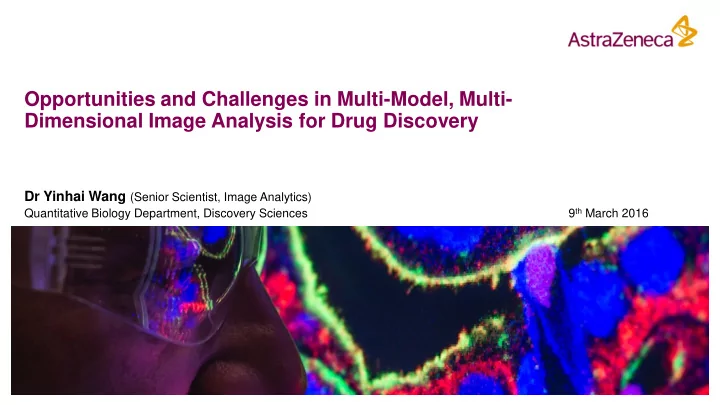

Opportunities and Challenges in Multi-Model, Multi- Dimensional Image Analysis for Drug Discovery Dr Yinhai Wang (Senior Scientist, Image Analytics) 9 th March 2016 Quantitative Biology Department, Discovery Sciences
the Quantitative Biology Department (QuBi) 2
Mass Spectrometry Imaging (MSI) 3
Mass Spectrometry Imaging
What is Mass Spectrometry Imaging? A single pixel in an MSI image is corresponding to a vector of numerical values. 200 400 600 800 m Fresh frozen sample an MSI image 5
What is Mass Spectrometry Imaging? 200 400 600 800 m 6
Why Mass Spectrometry Imaging? Relative Abundance Metabolite Drug Biomarker 200 400 600 800 m Mass of Charge Ratio (m/z) – ion beam 1. MSI is able to detect and visualise the chemical composition. 2. MSI has ability to describe metabolite, drug concentration and biomarkers simultaneously. 3. MSI is applicable to investigate drug’s efficacy and safety. 4. MSI is label-free. 7
MSI – Relationship Among Metabolite, Drug & Biomarker 8 *J. Cappell, University of Maastricht, unpublished work.
MSI + H&E 28 6 3.2 16 26 5.5 3 14 24 5 2.8 22 12 4.5 2.6 20 10 2.4 4 18 8 2.2 3.5 16 2 6 14 3 1.8 12 4 2.5 1.6 10 2 2 1.4 8 Haematoxylin & Eosin MSI images (H&E) To look at the morphology, tissue structure 9 *J. Cappell, University of Maastricht, unpublished work.
H&E 10
H&E 11 Y. Wang, et al. "Automated tumor analysis for molecular profiling in lung cancer." Oncotarget 6.29 (2015): 27938.
H&E + MSI (Metabolite) • The spatial distribution of metabolite • The correlation between tissue morphology with metabolite molecules 12
H&E + MSI (Drug) • The spatial distribution of drug X • The relative concentration of drug X at different tissue locations • The relationship between drug X and tissue morphology Drug X 13
H&E + MSI (Biomarker) • The location and spatial distribution of biomarker A • The relative level of expression of biomarker A • The relationship between biomarker A and tissue morphology Biomarker A 14
H&E + MSI (Metabolite, Drug, Biomarker) Foreseeable problems: 1. Image Registration between MSI and H&E 2. Visualisation 3. Tissue image processing (e.g. machine learning for the recognition of tumour *) 4. Multi-dimensional data analysis: • Multiple MSI images • MSI intensity + spatial locations • H&E tissue structure • Regional relationships • Relationship among metabolite, drugs and biomarkers) • Machine learning for rapid matching *Y. Wang, et al. "Assisted diagnosis of cervical intraepithelial neoplasia (CIN)." IEEE Journal of Selected Topics in Signal 15 Processing, 3.1 (2009): 112-121.
Immunohistochemistry (IHC) 16
Fluorescent Multiplexing 17
MSI + H&E + Immunohistochemistry (IHC) + Fluorescent IHC H&E MSI Fluorescent Multiple image modalities: m IHC + n H&E + p MSI + k Fluorescent 18
MSI for Dose Responses Foreseeable problems: Glutamate 1. Extra dimension of data 2. MSI Image registration (not from a same host) 3. The comparison of dose responses Aspartate Glutamine 19
MSI for Kinetics Foreseeable problems: Glutamate 1. Extra dimension of data 2. MSI Image registration (not from a same host) 3. The comparison of drug responses over a period of time Aspartate Glutamine 20
The 3D Spheroid Model 85% of early clinical trials for novel drugs fail. 21
MSI for 3D Spheroid Models 3D slices Foreseeable problem: 3-dimensional image reconstruction Comparison of complex 3D image data Liu, Xin, and Amanda B. Hummon. "Mass Spectrometry Imaging of Therapeutics from Animal Models to Three-Dimensional Cell 22 Cultures." Analytical chemistry 87.19 (2015): 9508-9519.
MSI Image Analysis Multiple image modalities: m IHC + n H&E + p MSI + k Fluorescent Multiple image dimensions: 2D + colour channels + dose responses + kinetics + 3D 23
£1 million + 1TB + 6 months later 24
25
What Machine Learning Could Do to Help? • MSI images are a stack of images. – The matching between tissue morphology/structure (from H&E) and MSIs – The matching between IHC expression and MSIs – The matching between Fluorescent signals and MSIs • We expect machine learning to play a key role in MSI image analysis, and be aware of the following factors: – Expert input – Uncertainty – Unknown 26
Summary 1. At AstraZeneca, we are investigating novel imaging modalities. 2. We are generating a large amount of multi-modal image data, and in turn leads to a large amount of multi-dimensional numerical data. 3. We are pursuing better image and data analytical methods, machine learning approaches to • Unleash the power of multiple image modalities (IHC + H&E + MSI + Fluorescent) • Unleash the power of multiple dimensional data (2D + colour channels + dose responses + kinetics + 3D) To better understand biology and drugs’ mechanism of actions. • 27
Acknowledgements AstraZeneca - Quantitative Biology Department •Claus Bendtsen John Aston •Domingo Salazar Carola Bibiane Schönlieb •Ian Barrett •Lars Carlsson (Sweden) •Johan Karlsson (Sweden) AstraZeneca - High Content Biology Group •Samantha Peel •James Pilling •Sinead Knight Ron Heeren Jo Cappell AstraZeneca - Drug Safety & Metabolism •Richard Goodwin 28
Thanks! Yinhai Wang (Senior Scientist, Image Analytics): yinhai.wang@astrazeneca.com Claus Bendtsen (Director, Quantitative Biology): claus.bendtsen@astrazeneca.com Richard Goodwin (Associate Principal Scientist, MSI): richard.goodwin@astrazeneca.com Confidentiality Notice This file is private and may contain confidential and proprietary information. If you have received this file in error, please notify us and remove it from your system and note that you must not copy, distribute or take any action in reliance on it. Any unauthorized use or disclosure of the contents of this file is not permitted and may be unlawful. AstraZeneca PLC, 2 Kingdom Street, London, W2 6BD, UK, T: +44(0)20 7604 8000, F: +44 (0)20 7604 8151, www.astrazeneca.com 29
Recommend
More recommend